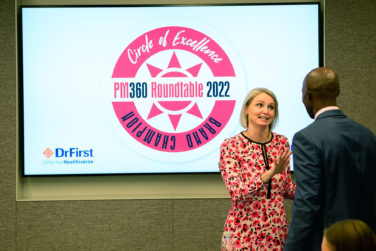It’s an understatement that the world as we know it now is different than the world as we knew it in January 2020. So naturally, the definition of success, as well as the steps taken to achieve that success when developing and launching a new pharmaceutical product, changed as well.
In January 2020, business operations, marketing, and every other part of a commercial product launch was running as they had been for the last decade: engagement through traditional marketing channels, deployment of large-scale field forces, a heavy focus on personal promotion with live, in-person engagement, and frequent touch points across key stakeholder groups. Pharmaceutical sales reps and customer-facing teams were out in droves, engaging directly with customers, and leaving marketing materials behind for the practice and their patients. But once the pandemic became a clear threat to the country in early-to-mid-March, companies were forced to switch gears, as they had to quickly adapt to the new COVID-19 environment.
Business Operations
As the country went into lock-down, many companies across the business world were forced to move to a remote work environment, quickly closing offices and grounding field-based teams. Companies scrambled to adapt business operations and minimize impact on the business. Many pharma companies developed internal COVID-19 task forces or committees to help make decisions and set policy related to operations, clinical programs, field activities, and employee support. Implementation and expansion of digital platforms were accelerated. Almost every part of the business was impacted in some way.
Marketing
One of the most noticeable changes in launch activity is the shift from personal promotion to digital tools and virtual channels. Instead of leaving behind brochures, sales reps are sending clickable PDFs, using templated communications to engage with their customers, and marketing teams are expanding websites to include more robust and educational content as a way to engage HCPs when they can’t visit in person.
Overall, manufacturers aren’t necessarily changing the content of their messaging, but rather they are finding new ways to deliver the messaging itself. As the pandemic continues to impact geographies and territories in different ways, companies need to be prepared to provide marketing materials in multiple formats to effectively support field teams still in the field and those still operating virtually.
For some therapeutic areas, there’s been a reallocation of budget to increase the spend on direct-to-consumer channels, as well as increased focus on empowering the patient. With patients at home and online more than ever, there is an opportunity to speak directly to the patient and support their care, whether it’s providing educational or support resources, or help finding treatment centers or providers.
Manufacturers are also testing the waters with virtual congresses, virtual ad boards, and virtual speaker programs, which is actually providing a new benefit in that they can reach a broader audience, as well as increase participation from the company’s senior leadership, since they are not restricted by the need to travel.
Field Team Implications
For the sales reps themselves, the customer-facing model as they knew it has likely changed for good into a combination of in-person and virtual engagements. And because of this, the profile of the sales rep is changing, with an increased focus on virtual selling skills, and teams are prioritizing virtual sales training, tools, and even lighting setups for virtual calls.
From a customer engagement standpoint, there seems to be a generational gap in the HCP’s comfort and willingness to engage on virtual platforms, which is something that manufacturers need to be prepared to address. Sales organizations should provide customers with multiple options for engagement and communication, whether that’s on a virtual platform (i.e., Veeva Engage, Zoom), by phone, or by email.
Teams are also placing a greater emphasis on existing HCP and practice relationships, since establishing new connections is that much more difficult right now. And instead of being able to visit an office and engage with the front desk, support staff, and the HCP, all in one visit, reps are setting up separate virtual calls with practice stakeholders—such as office managers, nurses, etc.
One of the benefits with virtual calls is that some HCPs actually will spend more time discussing a product virtually than an in-person discussion; however, sometimes it can be more difficult and time consuming to coordinate and schedule these interactions than it is to drop in or visit a practice in person.
Clinical Programs
The impact on clinical programs has been variable and largely dependent on the therapeutic area and disease state as well as the geographical location of the manufacturers and third-party logistics. When there has been an impact, it’s been by way of delayed or impeded patient recruitment, site closures or restrictions, or patient willingness to venture out during a pandemic, let alone introduce a new element to their healthcare regimens.
We also saw that some earlier stage clinical programs—often early-stage programs—were paused or delayed, as companies were forced to reassess spending and prioritize some programs during the pandemic. Some companies—in non-COVID therapeutic areas—are also reporting delays in their interactions with the FDA, as the agency is laser-focused on COVID-19 diagnostics, therapeutics, and vaccines.
What Hasn’t Changed
In spite of all that has changed, there are still some constants in the launch process. Fortunately, we have not seen many launches get pushed back or delayed and this is holding true across the spectrum of manufacturers for the most part. Small companies who are going through their first launch don’t necessarily have the ability to push back their timeline because of limited resources. And larger companies who do have the resources are that much more equipped to stay on track and deal with any changes that arise. So, in the sense of launch timelines, not much is changing.
Although marketing and field efforts have been forced to shift, the overall structure of commercial teams have not changed considerably. Surprisingly, field metrics also didn’t change much, despite a shift towards virtual engagement. Sales leaders have indicated that they’ve directed their teams to focus less on reach and frequency and more on “quality interactions” whether that is in-person, virtually, or by phone. And related to that, incentive compensation plans have remained relatively unchanged, even if the means for reaching those bonuses have changed. It might feel like a new game, but the goal is the same.
Best Advice Now
At this time, we would advise manufacturers and their partners to prioritize flexibility above all else. A lot of what we’re seeing, and how teams are currently operating, is likely to continue into 2021, and how we view customer engagement has probably changed for good.
In many ways, the commercial model has been evolving for years and COVID has just accelerated it. We don’t think it will go fully virtual, but we expect to see a combination of virtual and in-person to continue, both in terms of how pharmaceutical companies engage with customers, but also in how healthcare providers are engaging with patients.
People are resilient, and teams have quickly gotten comfortable with the new normal. Stay flexible, be creative, remain focused on relationships and delivering value, and we are confident that you can keep your launch on track and achieve launch success.










